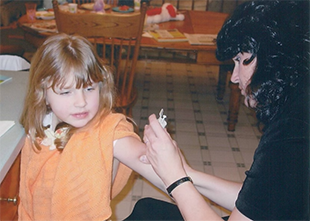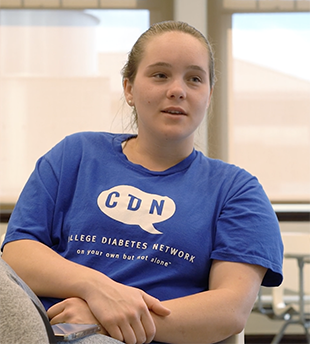Good-boy goldendoodle saves lives
November is National Diabetes Awareness Month
Featured StoriesSUMMARY: Julia Weaver (’21), the owner of a diabetic alert service dog, shares her experience living with Type 1 diabetes. The JMU chapter of Diabetes Link provides a support network for diagnosed students.
They say a dog is man’s best friend, but for one JMU employee, her dog offers more than friendship — he’s her lifesaving companion.
Maverick is Julia Weaver’s (’21) diabetic alert service dog. Weaver, a photographer and filmmaker for University Marketing and Branding, has Type 1 diabetes, so she must constantly monitor her blood sugar levels, which is where Maverick comes in. He uses the smell of her breath to alert her if her blood sugar is high or low by pawing her leg. When the scent of her breath changes, Maverick knows that something is wrong.
In his “service dog” uniform, Maverick stays by Weaver’s side, whether she’s in the office, at the gym, on photo and video shoots, or anywhere else she may go during her day.
 |
| Maverick is more than a dog to Weaver; he is also her lifesaving companion that paws her to let her know when her blood sugar is not in range. |
Maverick is serious and dedicated to his job, but as soon as Weaver says “Go play!” he runs over to her co-workers for petting and extra attention. “I call him the office therapy dog because I’ll just say the word, and he’ll go to everyone’s cubicle to say ‘hello,’” she said. In his free time, Maverick likes to run, play fetch and interact with people. “If there’s a Frisbee there, he’s all in,” Weaver said.
To keep track of her blood sugar levels, Weaver uses Dexcom, a continuous glucose monitor. When her CGM is not properly calibrated, she uses a glucometer to check the levels by pricking her finger.
|
“If you don’t have diabetes and you want to educate yourself, ask questions.” — Julia Weaver (’21) |
Maverick is most needed for Weaver during the night. She used to set alarms to ensure her blood sugar levels were in range when she slept. Weaver traded the alarms for Maverick, who wakes her up in case of emergency, giving her peace of mind while she sleeps.
Low blood sugar is much more of an immediate threat to Weaver than high blood sugar, although high blood sugar can cause long-term damage if left untreated. To bring her low blood sugar back up, Weaver must eat something, and to bring a high blood sugar back down, she needs insulin.
“I feel dizzy, hungry, anxious, nauseous, lightheaded. It takes significantly longer to pair my thoughts with words. I risk passing out and in the extreme, worst-case scenario could die if not treated quick enough,” Weaver said about blood sugar lows. High blood sugar is also harmful, but the effects are more long term, such as damage to the eyes, kidneys and nerves.
To bring her blood sugar to a normal level, she injects herself with insulin. In the worst cases of high blood sugar, Type 1 diabetics fall into diabetic ketoacidosis, where harmful substances called ketones build up in the body due to the lack of insulin; this can put Type 1 diabetics in the hospital.
Maverick started general training to become a diabetic alert service dog when he was 4 months old. As part of the training, Weaver mailed samples of her saliva to a trainer when her blood sugar was at different levels. The trainer would put a sample on their arm so Maverick could learn to associate the smell with the action of a paw. Weaver continues his training by affirming Maverick with ‘yes’ when he alerts her and gives him a treat.
Type 1 diabetes is an autoimmune disease that typically appears early in life but can appear at any age; most cases are under the age of 30. Weaver found out when she was 2 years old.
Weaver said a popular misconception about Type 1 diabetes is that people can eat their way to T1D, but it is autoimmune. “If you don’t have diabetes and you want to educate yourself, ask questions,” she said.

For Type 1 diabetics, beta cells that make insulin in the pancreas are completely destroyed. These diabetics are fully insulin-dependent. To receive the insulin, they inject themselves using pumps or shots. Fortunately, insulin pumps can now work with the CGM to give Type 1 diabetics the amount of insulin they need automatically, making care much more simplified.
Type 2 diabetes is generally found in older people who have unhealthy lifestyles. People with Type 2 diabetes have pancreases that produce insulin, but their blood does not receive it efficiently. One main difference between the two types is that Type 2 is curable and treatable, whereas Type 1 does not currently have a known cure and must be managed daily.
For those newly diagnosed with Type 1 diabetes, Weaver recommends the Juvenile Diabetes Research Foundation, JDRF, for more resources.
Maverick “is more than a service animal to me,” she said. “He’s really grown to be my best friend. I can’t imagine my life without him. I don’t know how I lived without him before.”
Diabetes Link provides a sense of community for students with Type 1 diabetes
A group of students sit in a circle eating dinner as they chat about how their weeks are going. One student shares how when she went to the pharmacy, it didn’t have her medicine.
Type 1 diabetes is a daily struggle for students who have it, and Diabetes Link provides a sense of community for them.

Katie Little, a senior Nursing major, started the JMU chapter of Diabetes Link in Spring 2021 after hearing about the club at George Mason University.
For Little and others, one of the hardest aspects of living with Type 1 diabetes can be the misconceptions and stereotypes. “I think a lot of people think that diabetes is something that only older, overweight people have, or people who sit on the couch all day and watch football and eat potato chips … I don’t even like potato chips, and I have diabetes,” Little said.
Little encourages politeness when asking about diabetes. “Something really important is that if you don’t understand something, to ask about it in a respectful way. Be curious and ask,” she said. Little has heard some interesting questions over the years. Someone once wondered if her Dexcom was a GPS tracker that she had to wear because she had been in prison.
During Diabetes Link meetings, members hold a picnic dinner and discuss various issues related to the diabetic community. Every week, Little asks a diabetes question of the day to spark conversation, while they enjoy each other’s company. “It’s really important to be able to surround yourself with people who understand what you’re going through and understand your situation,” Little said.
The club provides flyers for the University Health Center and Sentara RMH Medical Center for newly diagnosed JMU students. Diabetes Link also offers support to Rockingham County elementary students with diabetes.

